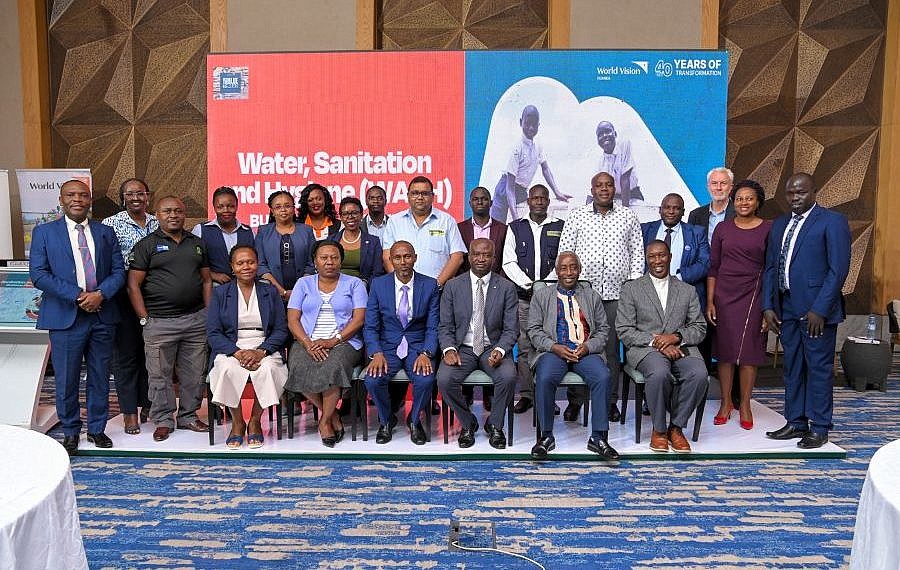Atleast three million Ugandans are set to benefit from a new Shs169.5 billion (USD 48.7 million) Water, Sanitation, and Hygiene (WASH) World Vision Business Plan launched to promote inclusive and climate-resilient WASH services across 41 districts.
The five-year plan, running from 2026 to 2030, was officially unveiled at Four Points by Sheraton in Kampala, bringing together government officials, development partners, civil society organizations, and financial institutions.
Speaking at the launch, Jeremiah Nyagah, the National Director of World Vision Uganda, described the initiative as “a bold and transformative roadmap” toward ensuring every Ugandan has access to safe water and sanitation.
“Mapping the Blue Thread is our vision to shape a future where water, sanitation, and hygiene catalyze improved health, safe learning environments, and lasting change,” Nyagah said.
He emphasized that partnerships between government, the private sector, and communities will be critical in achieving the plan’s goals.
“We can only realize sustainable impact when everyone plays their part—from policy to implementation. Communities must also take ownership of these water systems,” he added.
Nyagah also revealed that World Vision will deploy digital tools such as M-Water to promote transparency and real-time monitoring of WASH interventions, enabling stakeholders to track progress at every stage.
Wilfred Komakech, World Vision Uganda’s WASH Programs Manager, said the plan will deliver adaptive and innovative solutions that improve lives and create pathways out of poverty.
“We intend to reach over one million people with safe water, 1.1 million with sanitation, and 1.2 million with hygiene services,” Komakech explained. “The plan also targets 185 schools and 75 health facilities across the country.”
He added that the initiative is grounded in faith, community engagement, and innovation, and will be implemented in close collaboration with the Ministry of Water and Environment, National Water and Sewerage Corporation (NWSC), and financial partners such as ABSA Bank, Vision Fund, and Sanlam.
Representing the Deputy Speaker of Parliament, Kumi Municipality MP Silas Aogon commended World Vision’s ongoing partnership with government, delivering Deputy Speaker Thomas Tayebwa’s message which described the launch as a “significant milestone” in Uganda’s journey toward universal access to clean water.
“This plan is not just a document—it’s a bold commitment to improving lives, empowering communities, and building a healthier and more resilient Uganda,” Tayebwa’s message read.
He further emphasized that access to clean water and sanitation is foundational to all dimensions of development, improving health, education, and productivity—especially for women and children.
“When communities have reliable access to clean water and sanitation, children flourish, women are empowered, and disease burdens are reduced,” he noted.
Tayebwa also commended World Vision’s focus on climate-resilient infrastructure and digital monitoring, saying such innovations will enhance evidence-based planning and ensure long-term sustainability.
The 2026–2030 WASH Business Plan builds on the achievements of the 2021–2025 program, which expanded access to safe water in Buikwe, Kamwenge, and other districts, improved hygiene practices, and strengthened community ownership of facilities.
That earlier initiative helped thousands of households, schools, and health centers access clean water—reducing disease outbreaks and improving quality of life.
With this new plan, World Vision Uganda seeks to deepen its impact, scale innovations, and accelerate progress toward universal access to clean water and sanitation by 2030, in line with the Sustainable Development Goals (SDGs).
World Vision started working in Uganda in 1986, assisting communities in the ‘Luwero Triangle’ in central Uganda to resettle and rebuild their infrastructure after the 1981–1986 war. Activities extended to Arua and Nebbi districts in north-western Uganda to address poverty and the lingering destruction from the 1978–1979 war. World Vision then moved into Gulu in 1988, commencing relief programmes for internally displaced people at the start of the ongoing conflict in northern Uganda.
Hoima and Masindi districts, in western Uganda, were the next areas to come on board with the initiation of projects to tackle poverty and health problems. Then, in 1991, projects were started to address HIV/AIDS problems and to support orphans in Rakai and Masaka in southern Uganda.
Responding to the famine at Kamwezi in Kabale in 1993 was World Vision’s entry point into south-western Uganda. The organisation moved to the eastern region in 1995 with a project in Soroti to tackle the effects of cattle rustling and rebellion.

